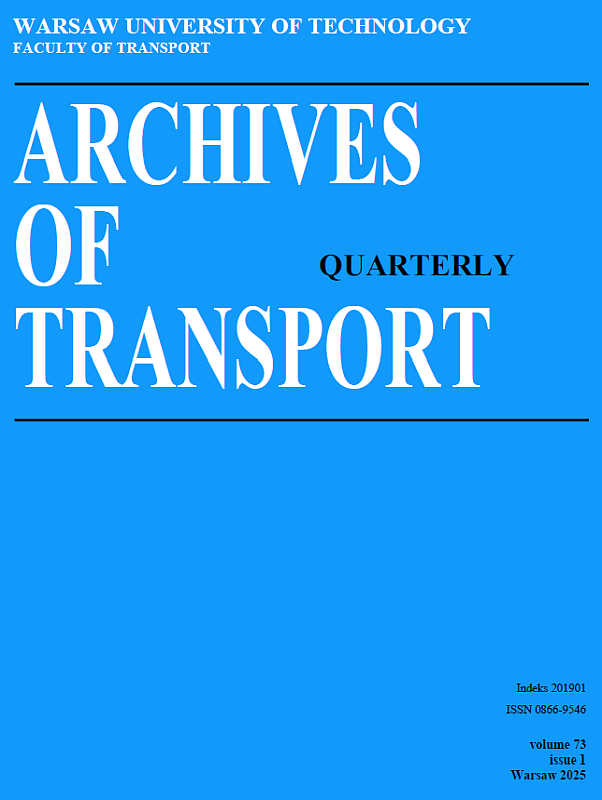Simulation and MCDA-based framework for border crossing process design with static and dynamic control of passenger flow
DOI:
https://doi.org/10.61089/aot2025.c16hsk18Keywords:
Border crossing point, Passenger terminal, Multi-stage and multi-level process structure, Dynamic simulation, TOPSIS ranking methodAbstract
This paper presents an approach combining simulation and multi-criteria decision analysis (MCDA) to model and evaluate options for passenger service organisation at a terminal. The methodology is motivated by changes planned by the EU concerning the introduction of the Entry/Exit System (EES) for advanced border control of passengers crossing the Schengen border having an impact on a passenger flow at the Border Crossing Point (BCP). The primary outcome is the selection of a recommended process configuration, including the types and number of servers required to ensure an efficient passenger flow within the BCP, and satisfactory service levels from the passenger's perspective. The authors propose a methodology that relies on a multi-stage and multi-level graph structure of the BCP. It enables the implementation of alternative technological solutions supporting border control, i.e., Manual Border Control (MBC), and automated solutions such as e-Gates (e-Gs) and Self-Service Kiosks (SSKs) to create a complex BCP structure. Unlike traditional approach, in this research both static and dynamic phenomena of traffic flow modeling, allowing for comprehensive control of passenger movement at the BCPs, is proposed. The research integrates traffic control, the composition of technical resources, staffing considerations, and spatial analysis into a single evaluative framework, providing a methodology to find the compromise solution for the process design. It consists of six stages: 1) analysis of the current state, 2) design of process variants and formalisation of evaluation criteria, 3) simulation models development for variants, 4) simulation of the current state and process variants, and analysis of results, 5) selection and application of the decision aiding method to find the compromise variant, and 6) result analysis. The proposed methodology has been applied to redesign the border control process at an airport terminal in the context of new border control procedures. Assuming that 39% of passengers require 10–120% more processing time due to new procedures, the recommended process includes new equipment configuration, increasing the total number of units by two. At the same time, the number of border guards remains unchanged, and the space required for passengers waiting in the queues is reduced by 30%.
References
1. Adacher, L., Flamini, M. (2021). Optimization of airport check-in service quality focused on operational costs and passengers’ satisfaction. PLoS ONE, 16(8), e0253586. https://doi.org/10.1371/jounal.pone.0253586
2. European Parliament, Council of the European Union. (2017). Regulation establishing an Entry/Exit System (EES) to register entry and exit data and refusal of entry data of third-country nationals crossing the external borders of the Member States and determining the conditions for access to the EES for law enforcement purposes, and amending the Convention implementing the Schengen Agreement and Regulations (EC) No 767/2008 and (EU) No 1077/2011. Official Journal of the European Union, (EU) 2017/2226.
3. FRONTEX (2017). Technical standards for Entry/Exit System (EES) equipment. Luxemburg: Publications Office of the European Union. https://doi.org/10.2819/814713
4. Greco, S., Ehrgott, M., Figueira, J.R. (2016). Multiple Criteria Decision Analysis. State of the Art Surveys. Springer New York, NY. https://doi.org/10.1007/978-1-4939-3094-4
5. Guitouni, A., Martel, J.-M. (1998). Tentative guidelines to help choosing an appropriate MCDA method. Euro¬pean Journal of Operational Research, 109, 501–521. https://doi.org/10/1016/S03772217(98)00073-3
6. Hsu, C.-I., Chao, C.-C., Shih, K.-Y. (2012). Dynamic allocation of check-in facilities and dynamic assignment of passengers at air terminals. Computers & Industrial Engineering, 63 (2), 410–417, https://doi.org/10.1016/j.cie.2012.04.003
7. Hwang, C.L., Yoon, K. (1981). Multiple Attribute Decision Making: Methods and Applications. New York: Springer-Verlag.
8. Jain, A.K., Ruiter, J.d., Häring, I., Fehling-Kaschek, M., Stolz, A. (2023). Design, Simulation and Performance Evaluation of a Risk-Based Border Management System. Sustainability, 15, 12991. https://doi.org/10.3390/su15171–2991
9. Jain, A.K., Satsrisakul, Y., Fehling-Kaschek, M., Häring, I., van Rest, J. (2020). Towards Simulation of Dynamic Risk-Based Border Crossing Checkpoints. In Proceedings of ESREL2020-PSAM15, 4446–4452. https://doi.org/10.3850/978-981-14-8593-0
10. Kalbarczyk, I., Kwasiborska, A., Gładyś, S. (2023). The Decision Support Facilitating the Check-In Service at the Chopin Airport with the Use of Computational Experiments in SIMIO. Transport, 38(2), 67–76. https://doi.org/10.38–46/transport.2023.18334
11. Kierzkowski, A., Kisiel, T. (2017). Simulation model of security control system functioning: A case study of the Wroclaw Airport terminal. Journal of Air Transport Management, 64 B, 173–185. https://doi.org/10.1016/j.jairtraman.2016.09.008
12. Kierzkowski, A., Kisiel, T. (2020). Simulation model of security control lane operation in the state of the COVID-19 epidemic. Journal of Air Transport Management, 88, 101868. https://doi.org/10.10¬16/j.jairtraman.2020.101868
13. Kierzkowski, A., Ryczyński, J., Kisiel, T., Mardeusz, E. (2024). Influence of the Configuration of Airport Security Control Systems on the Implementation of Assumptions of the Sustainable Development Policy. Sustainability, 16 (20), 8750. https://doi.org/10.3390/su16208750
14. Kiyildi, R.K., Karasahin, M. (2008). The capacity analysis of the check-in unit of Antalya Airport using the fuzzy logic method. Transportation Research Part A, 42, 610–619. https://doi.org/10.1016/j.tra.2008.01.004
15. Law, A.M., Kelton, W.D. (2000). Simulation, Modeling and Analysis. McGraw Hill, New York, NY.
16. Leone, L. (2002). Security System Throughput Modeling. In: 36th Annual 2002 International Carnahan Conference on Security Technology, pp. 144–150.
17. Li, J., Sun, Z., Zhang, Y. (2024). Study on departure passenger movement during security check process at airport terminal based on an improved cellular automata model. Physica A: Statistical Mechanics and its Applications, 633, 129393. https://doi.org/10.1016/j.physa.2023.129393
18. Mota, M.M. (2015). Check-in allocation improvements through the use of a simulation–optimization approach. Transportation Research Part A, 77, 320–335. https://doi.org/10.1016/j.tra.2015.04.016
19. Nie, X., Parab, G., Batta, R., Lin, L. (2012). Simulation-based Selectee Lane queueing design for passenger checkpoint screening. European Journal of Operational Research, 219(1), 146–155. https://doi.¬org/10.1016/j.ejor.2011.12.012
20. Roy, B., Słowiński, R. (2013). Questions guiding the choice of a multicriteria decision aiding method. EURO Journal on Decision Processes, 1, 69–97. https://doi.org/10.1007/s40070-013-0004-7
21. Ruiz, N., Giret, A., Alvarado, O., Perez, V., Rodriguez, R.M., Julián, V. (2014). Agent-Based Simulation for Border Crossing Modeling. Cybernetics and Systems, 45(8), 650–670. https://doi.org/10.1080/01969722.2014.970400
22. Sahoo, S.K., Goswami, S.S. (2023). A Comprehensive Review of Multiple Criteria Decision-Making (MCDM) Methods: Advancements, Applications, and Future Directions. Decision Making Advances, 1(1), 25–48. https://doi.org/10.31181/dma1120237
23. Sawicka, H. (2012). Metoda reorganizacji systemu dystrybucji towarów. Politechnika Warszawska, Rozprawa doktorska, Warszawa.
24. Sawicka, H. (2020). The Methodology of Solving Stochastic Multiple Criteria Ranking Problems Applied in Transportation. Transportation Research Procedia, 47, 219–226. https://doi.org/10.1016/j.trp¬ro.2020.03.092
25. Sawicki, P., Sawicka, H. (2021). Combined optimisation and MCDA based solution of the tram depot location problem. Archives of Transport, 60(4), 87–103. https://doi.org/10.5604/01.3001.0015.5970
26. Skorupski, J., Uchroński, P. (2015). A fuzzy reasoning system for evaluating the efficiency of cabin baggage screening at airports. Transportation Research Part C, 54, 157–175. https://doi.org/10.1016/j.trc.2015.03.017
27. Skorupski, J., Uchroński, P. (2018). Evaluation of the effectiveness of an airport passenger and baggage security screening system. Journal of Air Transport Management, 66, 53–64. https://doi.org/10.1016/j.jairtraman.2017.10.006
28. Wang, C-H., Chen, Y-T., Wu, X. (2021). A Multi-Tier Inspection Queueing System with Finite Capacity for Differentiated Border Control Measures. IEEE Access, 9, 60489–60502. https://doi.org/10.1109/ACCESS.2021.30–73470
29. Wang,Y., Meng, F., Wang X., & Xie, C., (2023). Optimizing the passenger flow for airport security check. Advances in Operation Research and Production Management, 1, 45–53. https://doi.org/10.54254/3029-0880/1/2023008
30. Yan, S., Tang, C-H., Chen, M. (2004). A model and a solution algorithm for airport common use check-in counter assignments. Transportation Research Part A, 38, 101–125. https://doi.org/10.1016/j.tra.2003.10.001
31. Yang, S.-P., Tang, T.-Q., Wang, T., Chen, L. (2023). How to Improve the Efficiency of Check-In Counter: A Counter-Sharing Method. Journal of Advanced Transportation, 2023, 4484202. https://doi.org./10.1155/2023/4484202
32. Yannis, G., Kopsacheili, A., Dragomanovits, A., Petraki, V. (2020). State-of-the-art review on multi-criteria decision-making in the transport sector. Journal of Traffic and Transportation Engineering, 7(4), 413–431. https://doi.org/10.10–16/j.jtte.2020.05.005
Downloads
Published
Data Availability Statement
All data are included in the text.
Issue
Section
License
Copyright (c) 2025 Archives of Transport journal allows the author(s) to hold the copyright without restrictions.

This work is licensed under a Creative Commons Attribution 4.0 International License.










